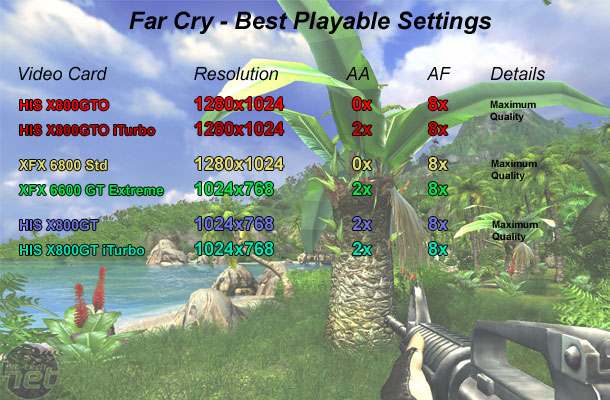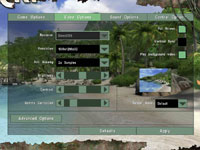Far Cry
Publisher: UbisoftWe used the full retail version of Far Cry patched to version 1.32. We did a manual run through of a section of the Factory level, which is both indoors and outdoors - the majority of our manual run through is taken from the start of the level, which is all outdoors. We also played through a section of the Fort level to ensure that our settings were playable in other graphic-intensive environments.
Far Cry was the first game to implement a High-Dynamic Range Lighting technique, based on the OpenEXR file format. The format allows all video cards with an FP16 frame buffer and support for FP16 blending to make use of the new lighting technique. At the moment, this method of HDR is only supported by NVIDIA's hardware, but we fully expect ATI's upcoming hardware to have support for FP16 blending and FP16 frame buffers.
Anti-Aliasing and Anisotropic Filtering were controlled from inside the game, and thus we left the drivers set to "Application Controlled".
Below is a table of the best-playable settings that we found best for each video card configuration. In this title, we found that 25 to 30 frames per second minimum and a target of 50 frames per second (or higher) to be the average frame rate in our manual run through. We found that this delivered a smooth and fluid gaming experience across the rest of the title, which were slightly less graphic intense than our manual run through.

We found the the XFX GeForce 6800 Std was was best-playable at 1280x1024 0xAA 8xAF, just like the HIS X800GTO operating at its default clock speeds. However, the X800GTO delivered a smoother experience than the 6800 Std, which delivered a frame rate not to dissimilar to the HIS X800GTO iTurbo when that card is playing the game at 1280x1024 2xAA 8xAF.
All of the remaining video card configurations were best playable at 1024x768 2xAA 8xAF with maximum in-game details. The XFX 6600 GT Extreme Gamer was the fastest of the three configurations, with an average frame rate well in to the mid 60's and a minimum frame rate of 29 frames per second.
The X800GT was slower than the 6600 GT in terms of average frame rate, but the minimum frame rates were 26 and 29 fps dependant on the operating mode used. We found that the average frame rate didn't change all that much - it moved from 54 frames per second to almost 56 frames per second. You can, however, tell that the HIS X800GT operating in iTurbo mode is as smooth as the XFX 6600 GT Extreme Gamer.

MSI MPG Velox 100R Chassis Review
October 14 2021 | 15:04








Want to comment? Please log in.